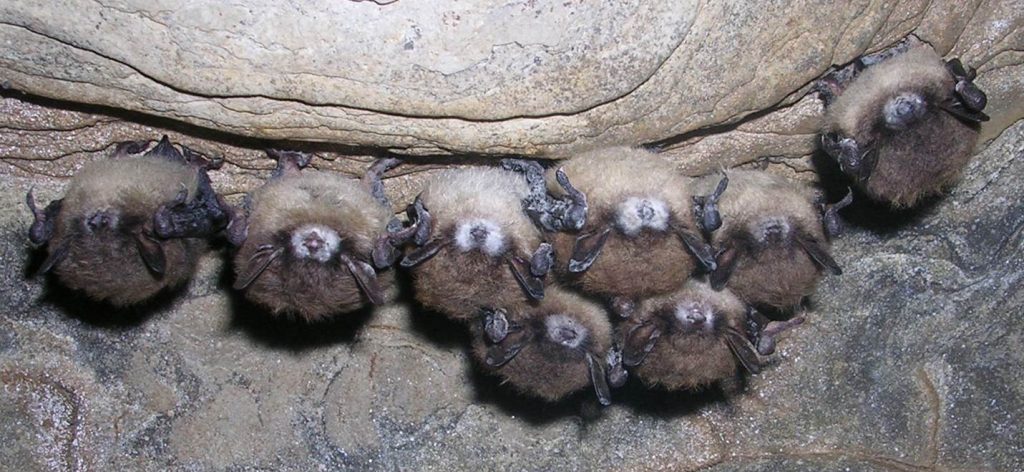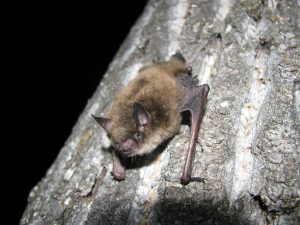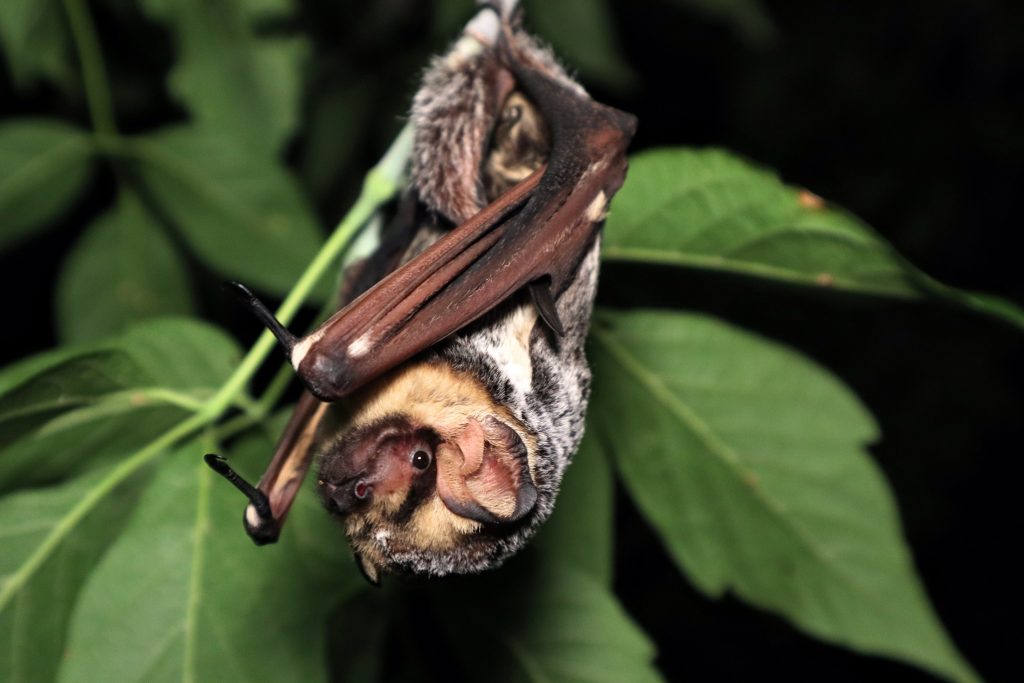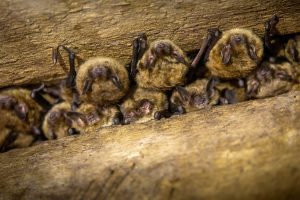Deadly Fungus Adds to Bat Conservation Concerns

BY CORY OLSON
Even under the best of conditions, winter is a challenging time for bats. The six species that spend the winter in Alberta must survive for about six months without food. Fewer than half of young bats make it through their first winter.1 However, those that survive into their second year typically live long lives – the current record for oldest known bat in North America is a little brown myotis from Alberta, which lived to over 38 years old.2
Bats are among the slowest-reproducing mammals on the planet and most bats produce only one pup per year. Their long lifespan and naturally low adult mortality (after their first winter) are essential for maintaining viable populations. Consequently, when die-offs happen, it can take a long time for bats to recover.
White-Nose Syndrome
Bats have a remarkable ability to manage energy reserves; however, few can withstand the devastating impacts of white-nose syndrome (WNS). This disease is caused by a fungus, Pseudogymnoascus destructans, that grows on bats during hibernation. Infection leads to more frequent arousals during the winter, depletion of energy stores, and eventual starvation. The fungus was brought to North America from Europe and was first detected in New York State in 2006. It has been spreading state-to-state and province-to-province since that time, resulting in catastrophic declines of hibernating bat populations wherever it spreads.
Bat species that are vulnerable to WNS have seen population declines exceeding 90% in affected regions.3 This has led to northern myotis and little brown myotis being listed as endangered under both the federal Species at Risk Act and, recently, the Alberta Wildlife Act. Those two species were among the first to be listed in part because their range extends into eastern North America, where WNS originally started. Catastrophic mortality in eastern cave hibernacula – over 98% in some cases – has been observed.
Western Canada has other myotis species that are now encountering the fungus. All five of the myotis species in Alberta are likely vulnerable to this disease to varying extent, so there is a high level of conservation concern.

A little brown myotis from northern Alberta. Cory Olson.
Wildlife Conservation Society Canada, with the assistance of several government, university, and community partners, began monitoring for the WNS fungus in western Canada in 2021. During our first year, we confirmed its presence in eastern and southern Saskatchewan, but none of our samples collected in Alberta and western Saskatchewan tested positive at that time. Unfortunately, that situation didn’t last long. In 2022, we confirmed the presence of the fungus along the Red Deer River, with several other inconclusive detections suggesting incursions along multiple fronts. The known range of this fungus in western Canada increased by more than 500 km in a single year, although the fungus was likely more widespread than we were able to detect.
The Alberta detections occurred a short distance northwest of Dinosaur Provincial Park, as well as at multiple points farther down the Red Deer River and along the South Saskatchewan River. There were also inconclusive detections along the Milk River in Alberta, and the Battle and Beaver Rivers in Saskatchewan, just east of the Alberta border. These are likely to be real detections, but lab results didn’t meet required thresholds, so follow-up monitoring will be completed this year to confirm those detections.

The badlands along the Red Deer River are riddled with cracks and caverns that several bat species use for hibernation. R. Schneider
The presence of the fungus along the Red Deer River is particularly concerning because of the importance of this area for hibernating bats. It is one of few locations in Alberta where bats have been observed to hibernate in places other than caves. The western small-footed myotis, long-eared myotis and big brown bat have all been found hibernating in this region. They spend the winter in deep cracks and crevices within the cliffs and steep slopes of the Red Deer River badlands.4 This area is the largest known hibernation area for multiple species of bats (though we have only begun to understand the winter behaviour of bats in Alberta). Furthermore, some bats likely follow the Red Deer River upstream to the Rocky Mountains, near caves where bats such as little brown myotis and long-legged myotis are known to hibernate. This makes the prospect of the fungus quickly spreading throughout Alberta much more likely.
Monitoring Efforts
In eastern North America, the presence of WNS is relatively easy to detect and monitor because bats hibernate in large numbers within large caves and mines. In the west, however, most of our bats appear to be wintering in scattered rock crevices that are inaccessible and, for the most part, unknown. To date, our detections of the WNS fungus have all been acquired through testing of guano samples taken from under bridges and in building roosts.
Although bats can fight the infection during the summer, through grooming and other defences, they still carry trace amounts of the fungus with them when they leave their hibernation sites in the spring. Therefore, monitoring summer roosts is an effective, non-invasive way to monitor the spread of the disease. Even trace amounts of the fungus can be detected in bat guano using current genetic sampling techniques (see “Scanning for Life Forms: Using Environmental DNA to Identify Species” in the spring 2022 issue of Nature Alberta Magazine).

A hoary bat from Alberta. White-nose syndrome is not a major threat to this species, but large numbers die each year because of wind turbines. Cory Olson
Two collaborative projects run by Wildlife Conservation Society Canada have been instrumental for locating roosts and monitoring the progression of WNS across western Canada. The first is the Alberta Community Bat Program’s community science initiative, which encourages people to submit reports of bat roosting locations and colony counts. Many landowners and conservation organizations have contributed to this database, which is now supporting multiple bat studies and monitoring projects in Alberta.
The second project, which has resulted in most of the fungus detections to date, is our survey of bridges that cross rivers and creeks. Along with our partners, we have already surveyed over 800 bridges across western Canada. Remarkably, more than half the bridges we’ve visited had bat guano that we could collect, usually conveniently sheltered on the undersurface of the bridge. Because bridges are widely dispersed across the landscape, we can collect samples in even the most remote regions of the country. Not only is this allowing us to monitor the spread of the fungus, but we are also using DNA barcoding to document the presence of different bat species, resulting in the largest-scale bat species inventory in Canada to date.
The Road to Recovery
Combating this disease is difficult because it spreads readily from bat to bat. Even bats that overwinter in Alberta may migrate up to 500 km between summer and winter habitats. This makes it all but certain that the disease will quickly spread, regardless of efforts to contain it.
Treatments are currently being tested that may one day help us to control WNS, but none of these will be ready in time to prevent the initial impacts of this disease in Alberta. The good news is that a small proportion of bats appear resistant to the fungus.5 There is hope that, with proper management, bats will eventually recover. The current priority is to avoid adding to the threats faced by bats and to address any additional bat mortality from other causes.
Perhaps no action is more important than ensuring that bats have healthy environments to live in. Healthy wetlands, ponds, and riparian areas produce abundant insect prey that enable young bats to grow quickly and bats of all ages to fatten for hibernation. Fat bats have higher overwinter survival, especially when faced with a white-nose syndrome infection. Also important is to ensure that bats are not disturbed during the summer when they are raising offspring, or during winter while they are hibernating. To support the management of bats in Alberta and ensure that we have populations of healthy, well-fed bats, we have developed several resources, which can be found on our website: albertabats.ca.

A little brown myotis maternity colony roosting in an old granary. Jason Headley.
With all the attention on WNS, it’s worth remembering that bats were a conservation concern even before the arrival of this deadly disease. Habitat loss has been a consistent issue, along with high fatality rates of bats at wind farms. The impacts of wind turbines on migratory bats is one of the most pressing conservation challenges in Alberta and is rapidly becoming worse with the manyfold increase in wind energy capacity now underway. Wind turbines do not appear to be a major threat to the six species that hibernate in Alberta. Instead, it is the three species that migrate to the U.S. in the fall that are primarily being affected: the hoary bat, silver-haired bat, and eastern red bat.
Hoary bats are one of the most spectacular and charismatic bat species in Canada. Population models for hoary bats predict extinction for this species if we don’t soon implement mitigation strategies to lower mortality rates at wind farms across North America.6 Eastern red bats and silver-haired bats have not been modeled but may experience similar declines. Status assessments for these species are already underway; however, opposition by industry is derailing meaningful actions. Unlike WNS, there are obvious solutions for reducing fatalities caused by wind turbines, and these need to be consistently implemented. Unfortunately, not enough is being done, and provincial wildlife directives are no longer up to the task of slowing this threat.
Between WNS and wind energy, few bat species remain secure in Alberta. Biologists are estimating that it could take centuries for our bat populations to recover to the numbers we are used to. But our first concern is to prevent populations from disappearing altogether. WNS and the other threats facing Alberta’s bats are not simple to solve, but solutions do exist. With enough people working on them, and with public support, these threats can be overcome. We need better policies, stronger wildlife directives, and substantial funding for wildlife in Alberta.
References:
- Frick, W.F., D.S. Reynolds and T.H. Kunz (2010). Influence of climate and reproductive timing on demography of little brown myotis Myotis lucifugus. Journal of Animal Ecology 79(1):128-136.
- Hobson, D. (2014). Bat hibernacula monitoring in Alberta for the winter of 2013/4. Western Canada Bat Network Newsletter 24:3.
- Cheng, T.L. et al. (2021). The scope and severity of white-nose syndrome on hibernating bats in North America. Conservation Biology 35(5):1586-1597.
- Lausen, C.L. and R.M.R. Barclay (2006). Winter bat activity in the Canadian prairies. Canadian Journal of Zoology 84(8):1079-1086.
- Langwig, K.E. et al. (2017). Resistance in persisting bat populations after white-nose syndrome invasion. Philosophical Transactions of the Royal Society B: Biological Sciences 372(1712):20160044.
- Friedenberg, N.A. and W.F. Frick (2021). Assessing fatality minimization for hoary bats amid continued wind energy development. Biological Conservation 262:109309.
Cory Olson is Program Coordinator for Wildlife Conservation Society Canada’s Alberta Bat Program. He is a Professional Biologist who has been working with bats for over 15 years.
This article originally ran in Nature Alberta Magazine – Spring 2023.
